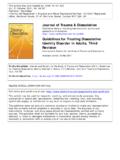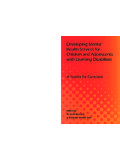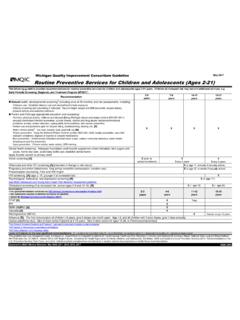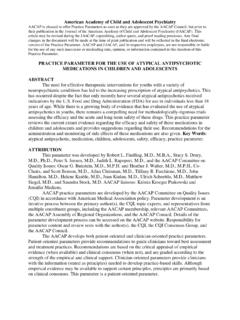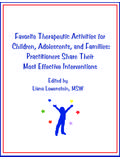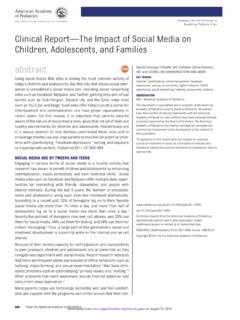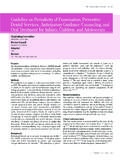Transcription of Guidelines for the Evaluation and Treatment of ...
1 Please note that this electronic prepublication galley may contain typographical errors and may be missing artwork, such as charts, photographs, etc. Pagination in this version will differ from the published version. Guidelines for the Evaluation and Treatment of dissociative Symptoms in children and Adolescents International Society for the Study of Dissociation The ISSD Task Force on children and Adolescents is pleased to present the Guidelines for the Assessment and Treatment of dissociative Symptoms in children and Adolescents. In utilizing these Guidelines , you might keep the following principle in mind. According to the Criteria for Evaluating Treat- ment Guidelines of the American Psychological Association (2000), Guide- lines should avoid encouraging an overly mechanistic approach that could undermine the Treatment relationship (p.)
2 2). We hope these Guidelines prove to be useful rather than prescriptive, and improve the care of children and ado- lescents with dissociative symptoms and disorders. Joyanna Silberg, PhD, Task Force Chairperson These Guidelines are dedicated to the memory of Elaine Davidson Nemzer, 1952-2000. These Guidelines were developed by the ISSD Task Force on Child and Adoles- cents and finalized in February 2003. Chairperson: Joyanna Silberg, PhD. Members: Frances Waters, Elaine Nemzer, Jeanie McIntee, Sandra Wieland, Els Grimminck, Linda Nordquist, Elizabeth Emsond. The committee thanks Peter Barach, James Chu, John Curtis, Beverly James, John O'Neil, Gary Peterson and Margo Rivera for critical comments and suggestions. Copyright 2003, by the International Society for the Study of Dissociation, 60 Revere Drive, Suite 500, Northbrook, IL 60062.
3 These Guidelines may be reproduced without the written permission of the International Society for the Study of Dissociation (ISSD). as long as this copyright notice is included and the address of the ISSD is included with the copy. Violations are subject to prosecution under federal copyright laws. Journal of Trauma & Dissociation, Vol. 5(3) 2004. Digital Object Identifier: 119. 120 JOURNAL OF TRAUMA & DISSOCIATION. I. RELATIONSHIP TO ISSD ADULT Guidelines . The International Society for the Study of Dissociation (ISSD) Standards of Practice Committee issued Guidelines for Treating dissociative Identity Dis- order (Multiple Personality Disorder) in Adults in 1994 and updated them in 1997 (ISSD, 1997). As these made no reference to children and adolescents, the ISSD Executive Council requested the Child and adolescent Task Force to draft Guidelines summarizing current clinical knowledge in the field applying directly to children and adolescents.
4 II. SCOPE OF DIAGNOSES ADDRESSED. Although the ISSD Adult Guidelines are specifically directed to the treat- ment of dissociative Identity Disorder (DID), dissociation in children may be seen as a malleable developmental phenomenon that may accompany a wide variety of childhood presentations. Symptoms of dissociation are seen in populations of children and adolescents with other disorders such as Post-Trau- matic Stress Disorder (PTSD; Putnam, Hornstein, & Peterson, 1996), Obsessive- Compulsive Disorder (OCD; Stien & Waters, 1999) and reactive attachment disorder, as well as in general populations of traumatized and hospitalized ad- olescents (Sanders & Giolas, 1991; Atlas, Weissman, & Liebowitz, 1997) and delinquent adolescents (Carrion & Steiner, 2000).
5 These Treatment principles, therefore, are intended for children and adolescents with diagnosed dis- sociative disorders, as well as for those with a wide variety of presentations ac- companied by dissociative features. In other words, the Guidelines identify general principles applicable to dissociative processes regardless of the child's1. presenting diagnosis. Diagnosis itself seldom communicates much about the nature of the child and his or her world. These Guidelines are not intended to be a basis for differ- ential diagnosis. While a dissociative diagnosis specifically geared to children has been proposed (Peterson, 1991), this has not been included in the Diagnos- tic and Statistical Manual of Mental Disorders, Fourth Edition, Text Revision (DSM-IV-TR; American Psychiatric Association, 2000).
6 Although even very young children appearing to meet the criteria for DID have been described (Putnam, 1997; Riley & Mead, 1988), the prevalence of DID in childhood is currently unknown. The diagnosis of dissociative Disorder Not Otherwise Specified (DDNOS) is the most common in populations of dissociative chil- dren and adolescents (Putnam et al., 1996), even though no diagnostic criteria have been set for this diagnosis. While individual case studies of children with 1 The word child is generally used in these Guidelines to mean both children and ad- olescents through high school age. International Society for the Study of Dissociation 121. puzzling and atypical dissociative presentations described variously as Deper- sonalization Disorder (Allers, White, & Mullis, 1997), dissociative Amnesia or dissociative Fugue (Coons, 1996; Keller & Shaywitz, 1986), and DID.
7 (Jacobsen, 1995) continue to be published in peer-reviewed journals, there is still no real consensus about the typical case and thus no consensus about diag- nostic criteria. For this reason, in these Guidelines the perspective on assess- ment and Treatment is symptom-based. III. INTRODUCTION. These Guidelines are derived from the published literature, material from conferences, and the clinical experience of members of the ISSD Child and adolescent Task Force. As this field is in an early developmental stage, these Guidelines are to be viewed as preliminary. As the field develops, they will be modified to incorporate new research into diagnosis and Treatment . In fact, the literature reviewed here, spanning over 16 years of reporting on dissociative phenomena in children , already shows shifts in emphasis and recommenda- tions over time (Silberg, 2000).
8 Despite the changing and provisional nature of our knowledge in this area, it is still important to have some Guidelines in ap- proaching dissociative symptomatology for the following reasons: 1. Treatment strategies aimed at increasing integration and reducing disso- ciation can be highly effective in treating some of the most seriously im- paired child victims of maltreatment who are engaged in disruptive and self-destructive behavior. 2. Information on the Treatment of dissociation was not available when most clinicians did their training, and it is important to organize clinical information to help familiarize clinicians with current Treatment ap- proaches. 3. Without careful consideration of developmental issues, the simplistic application of Treatment approaches for adult dissociation to children may be potentially dangerous to children .
9 For these reasons, these Guidelines are presented for the benefit of the ISSD. membership and the clinical community at large. It is our hope that research will continue to amend and refine these Guidelines , and that their presentation will stimulate discussion, debate and further analysis that will enrich the field as a whole. These Guidelines must be used in conjunction with all ethical 122 JOURNAL OF TRAUMA & DISSOCIATION. codes, health codes, laws or professional regulations that govern the individ- ual's discipline or place of practice. IV. QUALIFICATIONS OF CHILD. AND adolescent PRACTITIONERS. At this point in the development of this field, information about child and adolescent dissociation is still evolving. A good safeguard for doing no harm is a solid grounding in child development.
10 Clinicians who treat dis- sociative children should have training in child therapy and child development through accredited programs in their respective disciplines and be familiar with a variety of Treatment approaches for traumatized children (Cohen &. Mannarino, 1998b; Deblinger & Heflin, 1996; Donovan & McIntyre, 1990;. Friedrich, 1996; Gil, 1996; Heineman, 1998; James, 1989, 1994; Myers et al., 2002; Pearce & Pezzot-Pearce, 1997; Prior, 1996; Terr, 1991; Tinker & Wil- son, 1999; Wieland, 1997, 1998). In addition, it is recommended that clini- cians treating children with dissociative disorders participate in continuing education conferences, develop collegial relationships such as study groups or peer supervision, and stay current with the scientific literature.

